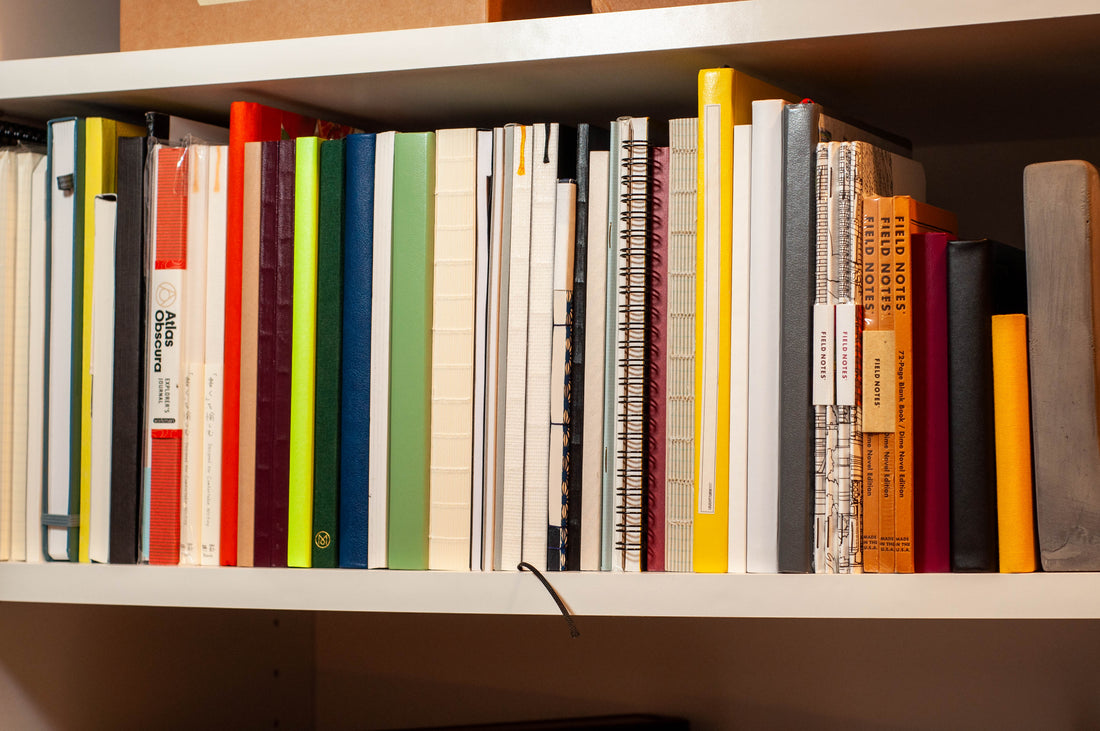
Unlocking the Power of Notebooks.
Share
How to Think Better, Work Smarter, and Create More
Ever bought a beautiful notebook only to leave it behind to collect dust? Sometimes completely blank?
You’re not alone. Many people love the idea of keeping a notebook but hesitate to use it.
- Some fear “ruining” their notebook with poor handwriting or mistakes.
- Others collect them but rarely put them to use.
- Many simply don’t know how to make a notebook part of their daily life.
I’ve been guilty of all the above. It’s hard for me to walk past a stationery store without picking something up, and over time, I built quite a stockpile of notebooks waiting for their time to shine.

Soon you'll get your chance dear notebooks, Soon.
But in the last couple of years, I changed my approach—and it has completely transformed how notebooks fit into my life. I want to share some of the lessons I’ve learned along the way.
This post will walk you through different types of notebooks, how they work, and how to find the system that fits you best. Because when used well, a notebook isn’t just paper—it’s a place where ideas take shape, work gets done, and creativity thrives.
Not All Notebooks Are the Same
If you’ve ever struggled to make a notebook part of your routine, the problem might not be you—it might be how you’re using it. Different notebooks serve different purposes, and finding the right system makes all the difference.
Let’s break down the most common notebook types and how they fit into real life.
Types of Notebooks and How to Use Them
Planner Notebook – For Schedules and Structure
The go-to for tracking deadlines, appointments, and daily tasks. Whether you prefer a daily planner, weekly layout, or monthly overview, this keeps everything organized so you never miss what matters. Perfect for those who thrive on structure.
Bullet Journal – For Custom Productivity
Half planner, half creative system, the Bullet Journal is for those who like flexibility. Use it to track tasks, habits, and ideas—all in your own format. If planners feel too rigid but you still want structure, this is the perfect balance.
Project Notebook – For Focused Deep Work
A dedicated space for long-term projects—whether you’re writing a book, launching a business, or designing something new. Many people rely on digital tools for this type of notebook, endlessly adding notes and clippings into apps. But the lack of physical interaction often leads to passive collection rather than active thinking. A physical project notebook forces focus and reflection, making every addition intentional.
Commonplace Book – For Collecting Ideas
A vault for interesting thoughts, quotes, and insights. Use it to store wisdom from books, articles, and conversations, building a personal library of inspiration over time. Less structured than a Reading Log, but perfect for seeing connections between ideas.
Reading & Research Log – For Learning with Purpose
If you read to learn, this notebook helps track what you’re reading, key takeaways, and personal reflections. Unlike a Commonplace Book, this is more structured, meant for active learning and study rather than collecting inspiration.
Sketchbook & Visual Notebook – For Thinking in Images
For designers, artists, and visual thinkers. Whether it’s mind maps, diagrams, or freeform sketches, this is where ideas take shape visually. No rules, just space to create.
Scratchpad – For Quick & Messy Thinking
A no-pressure space for brainstorming, capturing fleeting ideas, and jotting down whatever comes to mind. If you struggle with making a notebook “perfect,” a Scratchpad gives you permission to be messy and just get ideas down.
How to Find the Right Notebook for You
There’s no single “right” notebook—just the one (or ones) that fit how you think and work best. Instead of trying to force one notebook to do everything, ask yourself:
- What do I actually need? → Do you need structure (Planner)? A space for deep work (Project Notebook)? A place to capture random ideas (Scratchpad)?
- Do I need more than one? → Many people find a combination works best. A Scratchpad for quick thoughts + a Commonplace Book for long-term ideas is a popular duo.
For me, having a notebook beside me is invaluable for organizing thoughts and capturing ideas—even as a simple space to doodle. It’s also helped me reduce screen time, which is always a good thing.

As I go through my day, I add notes and store ideas to my Sikigu notebook. I don't care about the quality of the note, I use it to help me think through things.
But I don’t force all my tasks into a notebook. My planner stays digital, while I use a Project Notebook to quickly jot down ideas without worrying about formatting. And my Traveler’s Notebook? That’s my Commonplace Book, and it goes everywhere with me.
The key takeaway: A notebook should fit into your life—not the other way around.
Whether you use one or a mix, the best notebook system is the one that helps you think better, work smarter, and create more.



